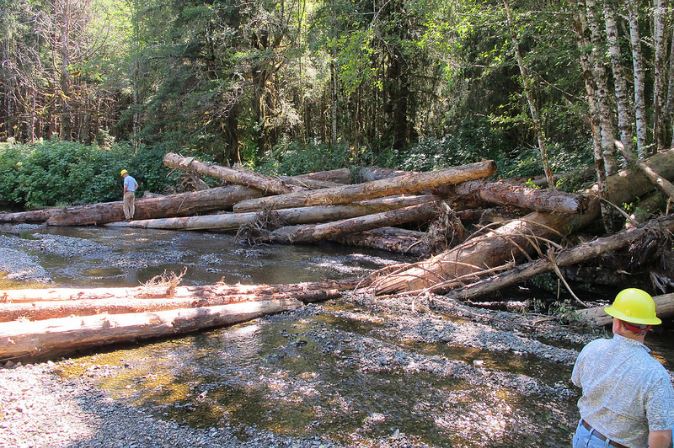
Forest Service employees Don Martin and John Lane inspect an in-stream restoration structure on 12-Mile Creek, on Prince of Wales Island. Many Sitkans want to encourage further efforts toward habitat restoration, rather than revisit the roadless debate which they consider closed following the 2016 Tongass Land Management Plan. (USDA photo/Ron Medel)
About 60 Sitkan packed into a conference room at the Aspen Suites Hotel on Monday evening (9-24-18) for a scoping meeting on the state’s petition to open more of the Tongass National Forest to roadbuilding.
Like a similar meeting held last week in Ketchikan, much of the input from the audience was focused not so much on the merits of roadless policy, but on the process itself.
Ken Tu is the interdisciplinary team leader for Alaska Roadless Rule-Making, with the US Forest Service.
He explained why the agency was soliciting public opinion.
“What we’re trying to do is develop a state-specific Roadless Rule which we believe would be a better approach than the 2001 Roadless Rule’s approach of one-size-fits-all,” Tu explained. “We believe that a state-specific rule would probably be better in the sense that we can tailor it to local concerns, and hopefully garner local support.”
The Roadless Rule was signed into law by President Bill Clinton just a few days before he left office in 2001. It made road-building off-limits in all areas of the US National Forests where roads were not already in existence.
Alaska immediately filed suit, and it’s remained in litigation for the last 17 years.
Many of those in attendance at Monday’s hearing believed that this latest effort was just another iteration of the original dispute — one which they felt was mostly resolved in the 2016 Tongass Land Management Plan.
Fisherman Eric Jordan thought this latest effort by Alaska to petition the Trump administration once again would divide Southeast communities.
“Those of us who have lived here know that Southeast Alaska is one community with different neighborhoods,” Jordan said. “And balkanizing the Roadless Rule really does not work in this community. Thank you.”
Larry Edwards, a long-time conservation advocate and former Greenpeace staff member, came down particularly hard on the process. The comments at Monday’s meeting weren’t becoming part of the official record — unless they were submitted in written form. Edwards thought that the Forest Service was again simply going through the motions, rather than trying to actually find consensus among the public for new roadless policy.
“There should have been a scoping meeting before that petition was even submitted (by the state),” said Edwards. “We shouldn’t be doing this. As far as these advisory committees, I’ve been a deep observer of two of them involving the Tongass: The Tongass Futures Roundtable, and the Tongass Advisory Committee, which was for the (2016) Forest Plan. And in my view those processes absolutely stink. It’s a way for the outcome to be manipulated by people in the government.”
Alaska Governor Bill Walker and the Forest Service signed a memorandum of agreement in August kicking off the scoping process. The agreement also called for a 13-member advisory committee to submit recommendations to the state by the end of November. No one’s been appointed yet.
Note: US Sen. Lisa Murkowski commented on the agreement between the state and the Forest Service during a visit to Sitka in August.
The Forest Service is holding similar meetings throughout Southeast as part of the scoping process. The deadline to submit written comments is October 15.
Ken Tu told the audience that the goal was to have a final Environmental Impact Statement prepared by the summer of 2020, and a final rule to the Secretary of Agriculture “shortly thereafter.”






























